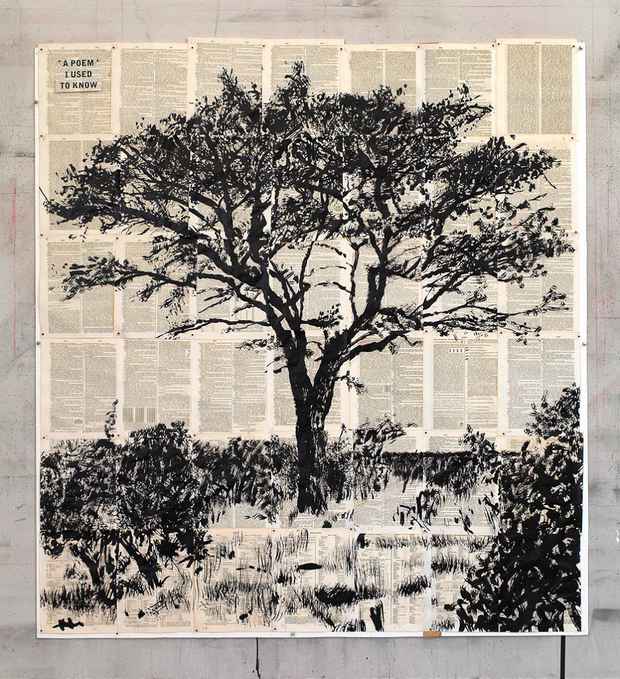William Kentridge “Second-hand Reading”
Marian Goodman Gallery

This event has ended.
The exhibition evolves out of works and projects begun in 2012: the Six Drawing Lessons, delivered as part of The Norton Lectures series at Harvard University in 2012 in which a consideration about work in the studio and the studio as a place of making meaning developed; and the recent 5-channel video and sound installation with breathing machine, The Refusal of Time.
Four different bodies of work will overlap and intersect: ink drawings on book pages, flip-book films and their drawings, kinetic sculptures, and linocuts. Concerns and directions in this body of work include, as Kentridge says, “taking sense and deconstructing it, taking nonsense and seeing if sense can be constructed from it …. This leads to the question of mistranslation, and the pressure that imperfect understanding gives to the act of imagination. Hence the fragments of brush marks on pages turning into trees, and the objects of the Rebus having alternative readings - seen this way, the bird becomes its own cage; the tree contains the man carrying the wooden load; the sphere, cone and cube of Cezanne contain multitudes.”
A series of large drawings of trees in Indian ink on found encyclopedia pages, torn up and reassembled, analyzes the form of different trees indigenous to southern Africa. Drawn across multiple pages from books, each drawing is put together as a puzzle – the single pages first painted, then the whole pieced together.
Three new ‘flip book’ films and framed blocks of drawings on found pages from which the films were made over the past year will be shown. Constructed from hundreds of new drawings, the films include self-portrait sequences of the artist, texts, geometric blocks of color, and calligraphic renderings. They include: In the North Gallery viewing room, NO IT IS, a triptych of flip-book films shown on three flat screens comprised of Workshop Receipts, The Anatomy of Melancholy, and Practical Enquiries (2012). In the South Gallery, Second-hand Reading (2013), with music by Neo Muyanga, will be projected. Sonnets (2012), a flip-book film edited to the rhythm and sound of Shakespeare’s Sonnet No. 18, will be shown on a flat screen. Created from panels of color painted onto book pages, the hues correspond to an exploration of colours for a future production of Alban Berg’s Lulu.
Rebus, 2013 is a new series of bronze sculptures and will be presented in two sets. Referring in title to the allusional device using pictures to represent words or parts of words, each individual bronze object forms two distinct images when turned to a certain angle. Each piece will be shown in the exhibition with its two views. When paired in correspondence, for example, a final image – a nude – is created from two original forms – a stamp and a telephone.
Kinetic sculptures with music and sound have their origin in both The Refusal of Time, shown at Documenta (13), and the performative piece Refuse the Hour, and are constructed from found objects such as bicycle wheels, sewing machines, bellows, megaphones, tripods and drums. They include Small Bellows, Wooden Kinetic Megaphone, Flag Kinetic Sculpture, Drum Machine, Steel Rotating Megaphone. A Singer sewing machine and a chorus of Singer sewing machines, perform music composed by Neo Muyanga, as does a rack of drums, with software design and circuitry for both done by Janus Fouché.
Rubrics, Colour Charts, and Universal Archive are new series of prints. Rubrics is a series of 14 red silkscreened texts which punctuate the space with phrases related to the series of Six Drawings Lessons, the Norton lectures presented at Harvard University last spring. Both the extensive linocut series titled Universal Archive, and the two Colour Chart prints were first made as ink drawings on paper, then transferred to lino and cut.
Kentridge writes, “Between these various bodies of work exist formal mistranslations: brush marks of ink drawings turn into linocuts; the two dimensional ink drawings turn into bronze sculptures. Some points of intersection: ink drawings to linocuts to bronzes; ink drawings to trees, with the brushes producing multiple marks for the leaves of trees. The requisitioning of old forms for new uses: encyclopedias are supports for drawings, sewing machines and a bicycle become sculpture. Words as provocations towards meaning rather than clear syllogisms: the phrases in the drawings push us to make some sense; the Rebus sculptures as hieroglyphs, placed in a line like a line of letters or words or syllables which can be rearranged to make new sentences.”
Media
Schedule
from September 17, 2013 to October 26, 2013
Opening Reception on 2013-09-17 from 18:00 to 20:00